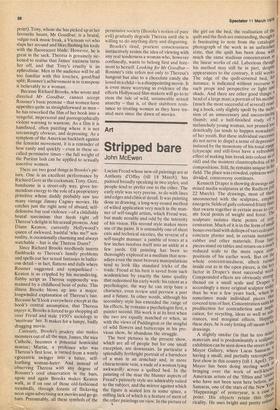Art
Stripped bare
John McEwen
Lucian Freud whose new oil paintings are at Anthony d'Offay (till 18 March), has painted broadly speaking in two styles, and people tend to prefer one to the other. The early style was very precise, to do with lines and edges and clinical detail. It was painting done as drawing, a long-way-round method of willed application very much in the manner of self-taught artists, which Freud was, but made notable and odd by the intensity of his vision. His second style makes more use of the paint. It is ostensibly one of short cuts and technical niceties, the reverse of a self-taught manner: a jumble of tones at a few inches resolves itself into an ankle at a few yards. Oil painting has been so thoroughly explored as a medium that nowadays even the most bravura manipulations tend to look like standard tricks of the trade. Freud at his best is saved from such academicism by exactly the same quality that redeemed his early work: his talent as a psychologist, the way he can strip bare a character, even review and preview a past and a future. In other words, although his secondary style has extended the range of his effects, he remains a psychologist first, a painter second. His work is at its best when the two are equally matched or when, as with the views of Paddington or the mugful of wild flowers and buttercups in his previous show, he abandons the struggle.
The best pictures in the present show, which are all of people but for one small exception, are downstairs. In particular a splendidly forthright portrait of a barndoor of a man in an armchair and, in more characteristic vein, a nude of a woman lying awkwardly across a quilted bed. In the painting of the man the blunter aspects of Freud's painterly style are admirably suited to the subject, and the mirror against which the figure is seated lets in some space, a stifling lack of which is a feature of most of the other paintings on view. In the picture of
the girl on the bed, the realisation of the quilt and the flesh are outstanding, though it is fascinating to note from the catalogue
photograph of the work in an unfinished state, that the quilt has been done with
much the same studious concentration as the linear works of old. Laborious though his method may still be in part, desPite appearances to the contrary, it still works. The edge of the quilt-covered bed, fnr instance, is indicated without recourse t° such props and perspective or light and shade. And there are other good things:0 head of a large man; a portrait of his mother (much the most successful of several) read' ing a book, only slightly spoilt by the inclu' sion of an unnecessary and unconvincing thumb; and a half-finished study of a melancholy young woman, not pruned too drastically (as tends to happen nowadaYs) ' of her youth. But these individual successes do not serve to dispel a sense of depressioa induced by the monotony of his tonal range (cityscape and still-lives have a refreshing effect of making him break into colour as rli! old) and the insistent claustrophobia of hr compositions. Still, he remains unique in his field. The place was crowded, opinions were divided, controversy continues. Kenneth Draper is showing drawings al mixed media sculptures at the Redfern (ti 22 March). The drawings, most of them unconnected with the sculpture, emPI°Y, energetic fields of gaily coloured frizzy line' that swarm together in certain areas to ate focal points of weight and force. Ti sculpture isolates these points of c°rIii centration. Much of it is in the form of arrls'A I boxes overlaid with dollops of vari-coloure" concrete plaster and, in certain instances' rubber and other materials. Four late! pieces stand on tables and return on a muc" reduced scale to the more open cora' positions of his earlier work. But on thel whole concentratedness, albeit turtle" inside out as in the open pieces, is the factor in Draper's most successful wor''' Compounded effects are obviously streng; thened on a small scale and Draper I accordingly a more original sculptor todaYe than he was a few years back, when II t sometimes made individual pieces tilt covered tens of feet. Concentration suits fr, predilection for contradiction and iulPhr, ' cation, for recycling, ideas as well as str; stances, and marginal effects. HaPPP5 these days, he is only letting off steam in 1" drawings. ,x• es A slightly similar (in that he too ru—ri materials and is predominantly a sculPte4 exhibition can be seen down the street at ri'i5 Mayor Gallery, where Lucas Samarns,,.ve having a small, and partially retrospeci."10 first show in this country (till 1 April).,! in ; Mayor has been doing sterling w0r0 bringing over the work of well-k°0 American artists of the 'fifties and 'aiXtl„d , who have not been seen here before, n''cii Samaras, one of the stars of the New Inn 'Happenings' of yesteryear, is a case oi, point. His objects retain this ti10 and decorates boxes and tables in strange and exotic ways, sticking to tufts of wool cotton-wool, gluing down bristling surfaces of sewing-pins, scattering kitchen knives about. He also sews together large patchwork paintings from gaily coloured stuffs and takes subtly distorted colour Photographs of himself with a Polaroid, usually in the nude. This may sound a bit surrealist, but Samaras was brought up in Greece and much of it derives from his childhood memories of his mother sewing, and the exotic reliquaries and mosaics of the Greek Orthodox Church. Made as a protest against received academic opinions of what art could and could not be, it ends of course ,a.s a Perfectly acceptable shard of the fash‘,43nable stylistic fragmentations of New
ork from the 'sixties on. His work is Pretty, but Samaras is more of a phenomenon than an artist.



































 Previous page
Previous page